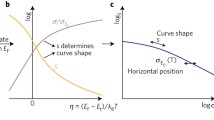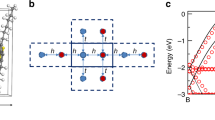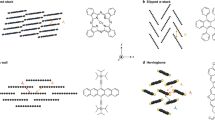Abstract
The molecular semiconductors exhibit a wide range of electronic properties not necessarily shown by conventional covalent or ionic semiconductors. Study of the conductive organic solids, particularly the polymeric as opposed to the charge-transfer type, is fruitful because of the deeper insights they offer as to carrier birth and transport in systems possessing short range order.
Conduction in the polymeric organic solids is of the hopping type, increasing with frequency of the applied field. As judged from the thermoelectric power, it may be dominated by either holes or electrons, depending upon the chemical makeup. It is not certain from Hall effects studies whether the Hall ‘mobilities’ are normal or suppressed, such as found in amorphous covalent solids. Both the intra- and inter-chain mobilities are frequency dependent.
Polarization in the polymeric organic solids is observed on occasions to become very large. This is due to a unique form of polarizability,nomadic polarization, wherein certain charges are free to roam over large ranges before being blocked. The large dielectric constants observed are temperature, pressure, and frequency dependent.
Similar content being viewed by others
References
P. S. B. Digby,Proc. Roy. Soc. B,161 (1965) 502–525.
B. A. Balto, Chap. 4 inOrganic Semiconducting Polymers, ed. J. E. Katon, (M. Dekker, New York, 1968) pp. 199–258.
S. Kanda and H. A. Pohl, Chap. 3 inOrganic Semiconducting Polymers, ed. by J. E. Katon, (Dekker, Inc., New York, 1968) pp. 87–198.
F. Gutmann and L. E. Lyons,Organic Semiconductors, (John Wiley and Sons, Inc., New York, 1967).
A. R. Blythe,Adv. Science, (1971) 371.
H. A. Pohl and J. R. Wyhof,J. Non-Cryst. Sol.,11 (1972) 137.
M. Pollak and T. H. Geballe,Phys. Rev.,122 (1961) 1742.
N. F. Mott,Festkorperprobleme,9 (1969) 22.
N. F. Mott,Phil. Mag.,19 (1969) 835.
N. F. Mott,ibid.,20 (1969) 163.
P. W. Anderson,Phys. Rev.,109 (1958) 1492.
J. R. Wyhof, “The Nature of Hyperelectronic Polarization,” Ph.D. Thesis, Oklahoma State University, Stillwater, Oklahoma, U. S. A., (1970).
A. Howie, C. Lima and H. A. Pohl, (1971) private communication.
L. Friedman,Phys. Rev.,140 (1965) 1649.
B. Rosenberg, “Semiconduction in Proteins,” N. Y. Acad. Sci., (1969).
J. W. Mason, R. D. Hartman and H. A. Pohl,J. Polymer Sci.,17c (1967) 187.
H. A. Pohl and E. H. Engelhardt,J. Phys. Chem.,66 (1962) 2085.
R. D. Hartman and H. A. Pohl,J. Polymer Sci.,A-1,6, (1968) 1135.
J. R. Wyhof and H. A. Pohl,J. Polymer Sci.,A-2,8 (1970) 1741.
H. A. Pohl,J. Polymer Sci.,17c (1967) 13.
R. D. Hartman, “Hyperelectronic Polarization and Related Electronic Properties of Macromolecular Solids: Organic Semiconductors,” Ph.D. Thesis, Oklahoma State University, Stillwater, Oklahoma, U. S. A., (1968).
H. A. Pohl, Chap. II inOrganic Semiconducting Polymers, ed. by J. E. Katon, (Dekker, Inc., New York, 1968).
R. Rosen and H. A. Pohl,J. Polymer Sci.,A-1,4 (1966) 1135.
H. A. Pohl, A. Rembaum and A. Henry,J. Am. Chem. Soc.,84 (1962) 2699.
V. A. Johnson and K. Lark-Horowitz,Phys. Rev.,92 (1953) 226.
V. A. Johnson,Prog. in Semiconductors,1 (1956) 63.
H. A. Pohl,Proc. Fourth Conf. on Carbon, ed. by S. Mrozowski, (Pergamon Press, 1960) p. 180.
H. A. Pohl and J. P. Laherrere,Proc. Fourth Conf. on Carbon, ed. by S. Mrozowski, (Pergamon Press, 1960) p. 259.
H. A. Pohl and R. P. Chartoff,J. Polymer Sci.,A-2 (1964) 2787.
H. A. Pohl and D. A. Opp,J. Phys. Chem.,66 (1962) 2121.
S. Tanaka and H. Y. Fan,Phys. Rev.,132 (1963) 1516.
M. Pollak,Phys. Rev.,133A (1964) 564.
M. Pollak,ibid.,138A (1965) 1822.
M. Pollak, Discussions Faraday Soc., No. 50, (1970) p. 12.
M. Pollak,Phil. Mag.,23 (1971) 519.
M. Pollak,J. Non-Cryst. Sol.,8–10 (1972) 486.
A. K. Jonscher,J. Non-Cryst. Sol.,8–10 (1972) 293.
C. Koops,Phys. Rev.,83 (1951) 121.
R. A. Marcus,J. Chem. Phys.,42 (1965) 2643.
M. Knotek, private communication, (1970).
H. Pellat,Ann. chim. phys.,18 (1899) 150.
H. Pellat,J. Phys.,9 (1900) 313.
P. Debye,Phys. Zeits.,13 (1912) 97.
P. Debye,Polar Molecules, (Chemical Catalog Co., New York, 1929).
H. Frölich,Theory of Dielectrics, (Oxford Press, 1958) Second Edition.
C. J. F. Böttcher,Theory of Electric Polarization (Elsevier Publishing Co., 1952) p. 367, p. 381.
R. M. Fuoss and J. G. Kirkwood,J. Am. Chem. Soc.,63 (1941) 685.
R. H. Cole and K. S. Cole,J. Chem. Phys.,9 (1941) 341.
W. J. DeVos and J. Volger,Physica,34 (1967) 272.
H. Eyring,J. Chem. Phys.,4 (1936) 283.
W. Kauzmann,Rev. Mod. Phys.,14 (1942) 12.
L. Friedman,J. Non-Cryst. Sol.,6 (1971) 329.
N. F. Mott,Phil. Mag.,6 (1961) 287.
N. F. Mott and W. D. Twose,Phil. Mag.,10 (1961) 107.
A. Miller and E. Abrahams,Phys. Rev.,120 (1960) 745.
N. F. Mott, Discussions Faraday Soc., No. 50, (1970) p. 7.
M. H. Cohen, H. Fritzsche and S. R. Ovshinsky,Phys. Rev. Lett.,22 (1969) 1065.
M. H. Cohen,J. Non-Cryst. Sol.,2 (1970) 432.
N. F. Mott and E. A. Davis,Electronic Processes in Non-Crystalline Materials, (Clarendon Press, Oxford, 1971).
A. J. Epstein, S. E. Etemad, A. F. Garitho and A. J. Heeger,Phys. Rev.,B5 (1972) 952.
A. N. Bloch, R. B. Weisman and C. M. Varma,Phys. Rev. Lett.,28 (1972) 753.
A. M. Hermann and A. Rembaum,J. Appl. Phys.,37 (1966) 3642.
H. A. Pohl and S. Rosen,Proc. Fifth Conf. on Carbon, Vol. II, ed. by S. Mrozowski, (Pergamon Press, 1963) p. 113.
A. Epstein and B. S. Wildi,J. Chem. Phys.,32 (1960) 324.
E. I. Balabanov, E. L. Frankevich and L. G. Cherkashina,Vysokomolek. Soedin,5 (1963) 1684.
A. A. Berlin, L. G. Cherakashina, E. L. Frankevich and E. I. Balabanov,ibid.,6 (1964) 832.
G. H. Heilmeier, G. Warfield and S. E. Harrison,Phys. Rev. Lett.,8 (1962) 309.
G. Delacote and H. Shott,Phys. Stat. Sol.,2 (1962) 1460.
G. H. Heilmeier and S. E. Harrison,J. Chem. Phys.,132 (1963) 2010.
E. M. Trukan,Fiz. Tverd. Tela.,4 (1962) 3496.
E. M. Trukan,Pribory Tekhn. Eksper.,4 (1965) 198.
E. M. Trukan,Biofizika,11 (1966) 412.
D. D. Eley and R. Pethig, Discussions of Faraday Soc., paper 17, (1971).
R. Pethig and K. Morgan,Phys. Status Sol.,B43 (1971) 119.
P. Fielding and F. Gutmann,J. Chem. Phys.,26 (1957) 411.
F. H. Winslow, W. A. Baker and W. A. Yager,J. Am. Chem. Soc.,77 (1955) 4751.
W. S. Chan and A. K. Johscher,Phys. Stat. Sol.,32 (1969) 749.
R. E. Scarman, “Resistivity of Some Organic Semiconductors as a Function of Frequency and Temperature,” Master's Thesis, Chelsea College, University of London, (1970).
J. Heleskivi, T. Salo and T. Stubb, Valtion Teknillinen Tutkimulaitos, No. 147, Helsinki, (1969).
C. Lemercier, private communication, (1971).
L. K. H. Van Beek,Physica,29 (1963) 161; 1323.
V. H. Schmidt, J. E. Drumheller and F. L. Howell,Phys. Rev.,B4 (1971) 4582.
J. H. T. Kho and H. A. Pohl,J. Polymer Sci.,A-1,7 (1969) 139.
M. J. Rice and J. Bernasconi,Phys. Lett.,A38, 277.
R. P. Auty and R. H. Cole,J. Chem. Phys.,20 (1952) 1309.
D. D. Eley, R. J. Mayer and R. Pethig,J. Bioenerg.,3 (1972) 271.
Author information
Authors and Affiliations
Rights and permissions
About this article
Cite this article
Pohl, H.A. Quasi one-dimensional electronic conduction and nomadic polarization in polymers. J Biol Phys 2, 113–172 (1974). https://doi.org/10.1007/BF02308899
Issue Date:
DOI: https://doi.org/10.1007/BF02308899




